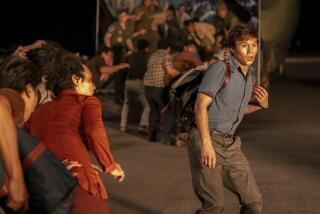In Crowded Streets of Phnom Penh, Past Collides With Future
PHNOM PENH, Cambodia — “In the old days we had so many elephants,” says the guide, glancing sadly at the empty stables of the Royal Palace. “Now, there are only statues.”
Just a short jog from the 19th century palace--fairy tale remnant of a vanishing Cambodia--destitute migrants from the countryside prepare watery gruel over an open fire. Their threadbare sleeping mats are spread under the sheltering branches of a rain tree in the park.
Forced to beg in the streets by the blast of a land mine, a young man sits among them on a stone slab, his truncated left leg dangling. From her mother’s embrace protrudes the rickety arms and wistful, sad eyes of a baby girl.
*
I run on, following a route I’ve come to know intimately in this capital of a tragic country that has beguiled, and repelled, me for a quarter century.
Not whirring by in a car, pausing to talk with regulars along my trail, I’ve observed over the years both the passing of old Phnom Penh and its constants, including patient suffering and inordinate greed.
At the end of Lotus Temple Park, I have to dodge a Mercedes- Benz that also scatters street vendors and strollers as its chauffeur careers through at high speed, horn blaring. A fleshy-faced man sits in the back seat, mouth glued to a mobile telephone.
*
Flashbacks from my time in the war-torn capital of the early 1970s: businessmen hoarding rice to amass profits while children starved, and officials siphoning off aid earmarked for dirt-poor peasants. I remember driving at high speed down “rocket alley,” near the park, trying to evade artillery shells sold to the Khmer Rouge insurgents by corrupt generals.
“Hello, hello,” a band of lively kids calls out, joining me for a few hundred yards. Their school bags bob on their backs as they practice English on the run.
Peeling off, they wave and smile, as do the park squatters, as I remember countless others doing on previous visits. Like 6-year-old Ban Boray, with the lovely oval face of Cambodian children and her left shoulder ripped off by bombs mistakenly dropped on her village by an American B-52.
She sat rigidly on a hospital floor, surrounded by flies and pools of urine. Every stirring of air that brushed her exposed collarbone and flesh seared her with pain.
New to Cambodia, and an American, I thought her eyes would burn with anger. As I interviewed her parents, our eyes met. Her expression flickered between haunted and almost mischievous. Then she smiled.
I wonder if Ban Boray is still alive, a woman of 29 who survived war’s cross-fires, brutal revolutionaries and officials perennially absorbed in political intrigue and swindling. The chances are so, so slim.
*
A breeze sweeps up from the river to douse some of the still blazing heat as I continue for another round: from Victory Monument honoring Cambodia’s war dead, through the two adjoining parks and to the walled Palace compound.
Pushcarts dispense sugar cane juice and fish paste noodles, a Cambodian specialty, to customers sitting on tiny stools set in the grass. Barbers shave and cut, their mirrors strung from tree branches. Wrapped in a sarong, a young woman modestly and with dignity ladles her evening bath out of a bucket.
The new, nine-story Hong Kong Center, its green-tainted windows reflecting glare, forms an incongruous backdrop to such village-like scenes. But it is certainly a signpost to the future Phnom Penh.
Nearby, along Sihanouk Boulevard, the “Videorama” shop displays cassettes of “Los Angeles 2013,” “The Hunchback of Notre Dame” and other Hollywood films. The Banana Center, a private school, advertises English, Japanese, Internet and computer accounting courses.
Most of Phnom Penh’s 1 million inhabitants can’t afford any of this, certainly not my friends in the park, like the skinny, barefoot preteen boys who get 1,500 riel (50 cents) a day for boxing 15 rounds to attract buyers of dubious cure-all medicaments.
Nor the “tree people,” 20 families from eastern Cambodia who trudged to Phnom Penh to seek manual labor and beg after last year’s floods destroyed their rice fields.
“Some days, we have no rice, so we must go to a pagoda to ask the monks. The government doesn’t help us at all,” says Luong Sokhom, 31, whose left leg was shattered by a mine. “And if the government doesn’t help us on our farms, we can’t go back to plant our fields.”
*
A sinking sun ignites the spires and sweeping roofs of the Palace when I finish my run and stop to chat with Bun Phalla, guide at the recently restored stables, where the king’s elephants were kept in times gone by.
As a young girl, she came on weekends to feed them sugar cane. There were half a dozen, she remembers, including one potent symbol of kingly power, an albino elephant.
Then, in 1975, the ultra-communist Khmer Rouge captured the city and began its reign of terror. Once ruler of a graceful, peaceful land, Norodom Sihanouk became a prisoner in his own palace while some 2 million of his countrymen perished.
Sihanouk survived, but if his recent predictions prove true, he will be the last king of Cambodia.
The elephants did not survive. Bun Phalla says they starved to death.
Now, on the lawn in front of the stables, craftsmen apply a coat of gray to an elephant family: a tusker, a female and cute calf in concrete.
More to Read
Sign up for Essential California
The most important California stories and recommendations in your inbox every morning.
You may occasionally receive promotional content from the Los Angeles Times.










